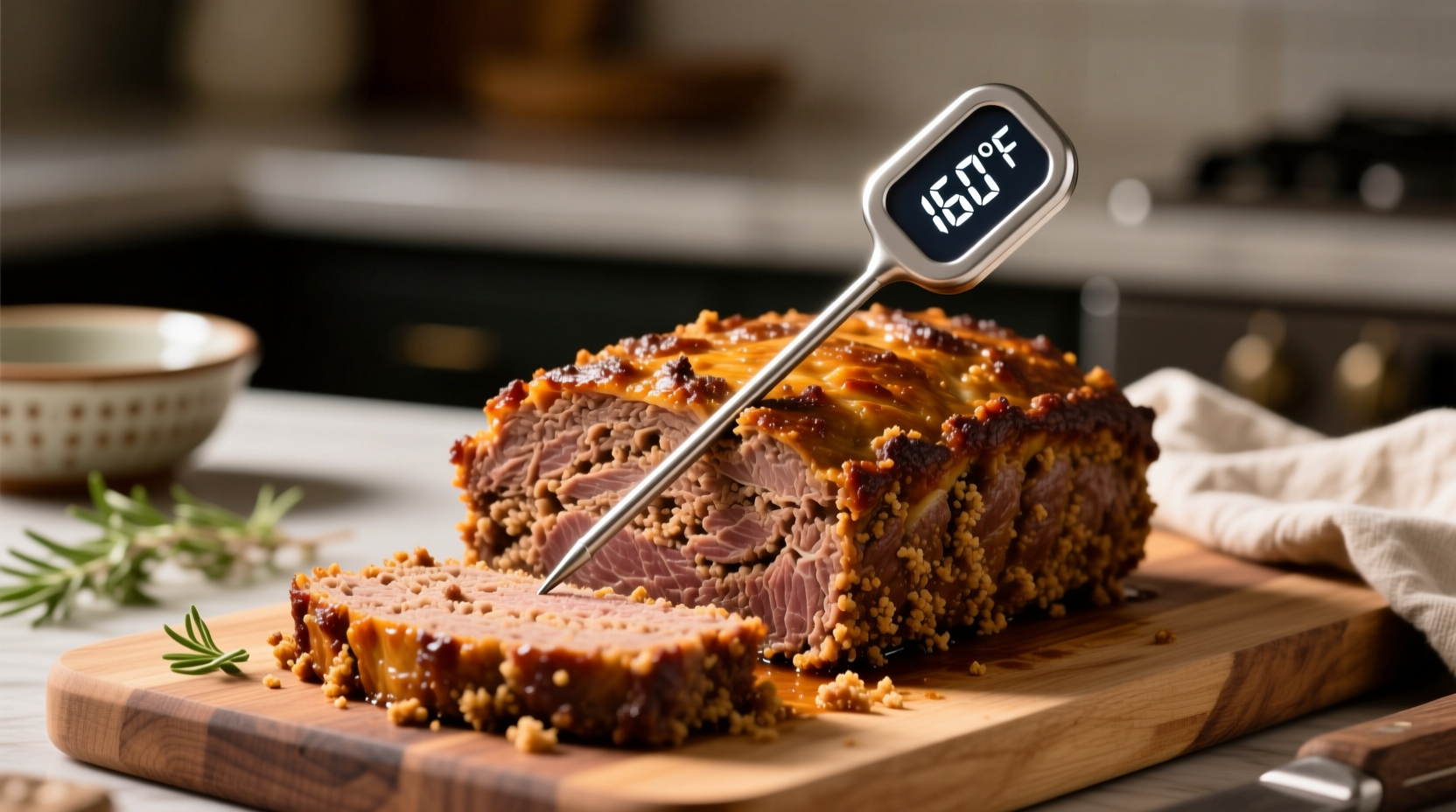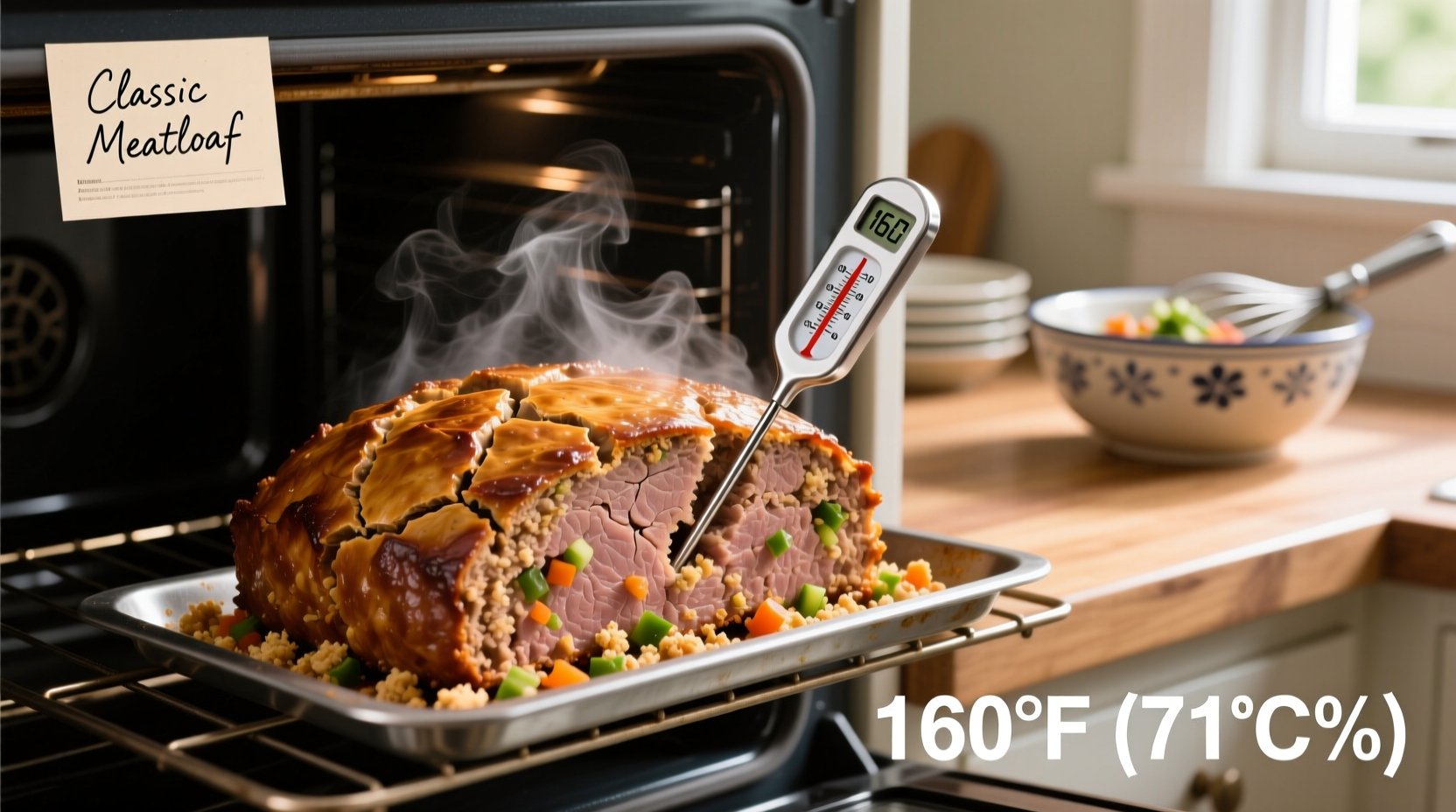For a standard 2-pound meatloaf cooked at 375°F (190°C), bake for 45-55 minutes until the internal temperature reaches 160°F (71°C). Always verify doneness with a meat thermometer for food safety.
Getting meatloaf cooking time right separates a juicy, flavorful centerpiece from a dry disappointment. As someone who's tested hundreds of meatloaf recipes across professional kitchens and home ovens, I've seen how minor timing adjustments dramatically impact results. This guide cuts through confusing online advice to deliver precise, science-backed timing you can trust—whether you're making a classic recipe or experimenting with new ingredients.
Why Exact Cooking Time Matters for Meatloaf
Unlike whole cuts of meat, ground meat in meatloaf requires precise temperature control. The USDA Food Safety and Inspection Service mandates that ground beef reach 160°F (71°C) to eliminate harmful bacteria like E. coli. Undercooked meatloaf risks foodborne illness, while overcooked versions become dry and crumbly. The sweet spot combines food safety with optimal texture.
| Meatloaf Size | Oven Temp | Recommended Time | Internal Temp |
|---|---|---|---|
| 1.5 lbs | 375°F (190°C) | 35-45 minutes | 160°F (71°C) |
| 2 lbs | 375°F (190°C) | 45-55 minutes | 160°F (71°C) |
| 2.5 lbs | 350°F (175°C) | 60-70 minutes | 160°F (71°C) |
| Muffin tin portions | 375°F (190°C) | 20-25 minutes | 160°F (71°C) |
4 Critical Factors That Change Your Cooking Time
1. Meat Composition and Moisture Content
Ground beef with higher fat content (80/20) cooks faster than lean blends (93/7) because fat conducts heat more efficiently. Adding moisture-rich ingredients like grated vegetables or ketchup extends cooking time by 5-10 minutes as water evaporates. For every ¼ cup of added liquid ingredients, increase baking time by 5 minutes.
2. Pan Selection and Heat Distribution
Meatloaf baked in a loaf pan traps steam, creating a steaming effect that reduces cooking time by 10-15 minutes compared to free-form loaves on a baking sheet. Dark metal pans conduct heat faster than glass or ceramic, potentially cutting baking time by 8-12 minutes. Always place your loaf in the oven's center rack for even heat circulation.
3. Oven Accuracy and Altitude Considerations
Most home ovens fluctuate ±25°F from the set temperature. An oven thermometer confirms actual heat levels—critical since a 25°F variance changes cooking time by 15%. At high altitudes (above 3,000 feet), water boils at lower temperatures, requiring 5-10% longer cooking times. The FDA notes that altitude adjustments become necessary above 2,000 feet for moist-heat cooking methods.
4. Carryover Cooking Effect
Meatloaf continues cooking after removal from the oven due to residual heat—a phenomenon called carryover cooking. A 2-pound loaf gains 5-10°F during the essential 10-minute resting period. This is why you should remove meatloaf at 155°F, allowing it to reach the safe 160°F threshold while resting. Skipping this rest causes juices to escape when sliced.
Step-by-Step Perfect Meatloaf Timing Guide
Preparation Phase: Set Yourself Up for Timing Success
Mix ingredients gently to avoid overworking the meat, which makes the loaf dense and extends cooking time. Chill the mixture for 30 minutes before shaping—cold meat holds its form better and cooks more evenly. Use a digital kitchen scale for consistent portioning; visual estimates vary by up to 30% according to USDA household measurement studies.
Cooking Phase: The Critical First 30 Minutes
Preheat your oven fully (15-20 minutes) before baking. For the first third of cooking time, avoid opening the oven door—each peek drops the temperature by 25-50°F, adding 2-3 minutes per interruption. At the halfway point, baste with sauce if desired, but keep the door closed as much as possible. Insert your thermometer probe horizontally through the side for the most accurate reading.
Doneness Verification: Beyond the Timer
While timers provide estimates, only a meat thermometer gives certainty. Insert it into the thickest part, avoiding the pan bottom. The USDA Food Safety and Inspection Service confirms ground meats are safe at 160°F with no pink remaining. If you lack a thermometer, press the loaf gently—it should feel firm but slightly springy, not soft or rock-hard. Clear juices (not pink) flowing from pierced areas indicate proper doneness.
Resting Phase: The Often-Skipped Final Step
Let meatloaf rest covered with foil for 10 minutes minimum. This allows proteins to reabsorb juices and the internal temperature to stabilize. Cutting too soon releases up to 40% of moisture according to American Test Kitchen experiments. For make-ahead meals, refrigerate leftovers within 2 hours—never leave cooked meatloaf at room temperature longer than 90 minutes.
Common Timing Mistakes and How to Avoid Them
- Guessing instead of measuring: Eyeballing loaf size leads to inconsistent results. Use a 9x5-inch loaf pan for standard recipes.
- Trusting oven timers: Built-in oven timers often drift over time. Use a separate kitchen timer for accuracy.
- Ignoring thermometer calibration: Test your thermometer in ice water (should read 32°F) or boiling water (212°F at sea level).
- Overfilling pans: A loaf pan more than ⅔ full causes uneven cooking. For larger batches, divide into multiple pans.

When Standard Times Don't Apply: Special Cases
Certain variations require timing adjustments you won't find in most recipes. Meatloaf with substantial vegetable content (like zucchini or mushrooms) needs 5-10 extra minutes as moisture evaporates. Gluten-free binders like oats or breadcrumbs absorb more liquid, extending cooking time by 8-12 minutes. For convection ovens, reduce temperature by 25°F and check 15 minutes early—forced air circulation speeds cooking by 20-25%. Frozen meatloaf requires 50% more time than fresh, but never cook from completely frozen without recipe adjustments.
Perfect Meatloaf Timing Checklist
- Verify oven temperature with independent thermometer
- Weigh meat mixture for consistent sizing
- Set timer for minimum recommended time
- Check internal temperature 10 minutes before expected finish
- Continue checking every 5 minutes until 160°F is reached
- Rest covered for 10 minutes before slicing











 浙公网安备
33010002000092号
浙公网安备
33010002000092号 浙B2-20120091-4
浙B2-20120091-4